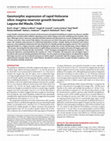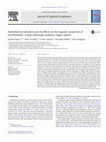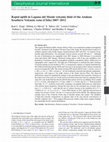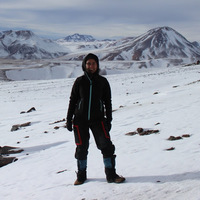Papers by Maria Loreto Cv
2015 AGU Fall Meeting, Dec 16, 2015

Geophysical Research Letters, Aug 18, 2015
The Laguna del Maule (LdM) volcanic field in the southern volcanic zone of the Chilean Andes exhi... more The Laguna del Maule (LdM) volcanic field in the southern volcanic zone of the Chilean Andes exhibits a large volume of rhyolitic material erupted during postglacial times (20-2 ka). Since 2007, LdM has experienced an unrest episode characterized by high rates of deformation. Analysis of new GPS and Interferometric Synthetic Aperture Radar (InSAR) data reveals uplift rates greater than 190 mm/yr between January 2013 and November 2014. The geodetic data are modeled as an inflating sill at depth. The results are used to calculate the temporal evolution of the vertical displacement. The best time function for modeling the InSAR data set is a double exponential model with rates increasing from 2007 through 2010 and decreasing slowly since 2010. We hypothesize that magma intruding into an existing silicic magma reservoir is driving the surface deformation. Modeling historical uplift at Yellowstone, Long Valley, and Three Sisters volcanic fields suggests a common temporal evolution of vertical displacement rates.
2014 AGU Fall Meeting, Dec 17, 2014
Bulletin of Volcanology, May 19, 2021
The Laguna del Maule volcanic field in Chile has been exhibiting unrest since 2005. New GPS and I... more The Laguna del Maule volcanic field in Chile has been exhibiting unrest since 2005. New GPS and InSAR data reveal a second episode of accelerated deformation beginning in late 2016 and continuing through May 2020, with an uplift rate >290 mm/year between 2019 and 2020. To explain the spatial and temporal pattern of deformation, we apply a dynamic model of viscous magma flowing through a conduit into a fluid-filled reservoir surrounded by a heterogeneous, viscoelastic crust. A Monte Carlo procedure optimizes the ellipsoid reservoir geometry and the inlet pressure history. The two episodes of accelerating uplift are each modeled with a pressure increase rate of ∼9 MPa/year. Since 2016, 0.10 km 3 of magma was injected into the system for a total of 0.37 km 3 since 2005.
AGU Fall Meeting Abstracts, Dec 1, 2019
AGU Fall Meeting Abstracts, Dec 1, 2020

Earth and Planetary Science Letters, 2021
Abstract In December of 2017, a lava dome emerged at the Nevados de Chillan volcanic complex in t... more Abstract In December of 2017, a lava dome emerged at the Nevados de Chillan volcanic complex in the southern Andean volcanic zone, Chile, at the base of a summit crater excavated by explosions during two preceding years of unrest. This posed a number of potential hazards to the surrounding touristic region, so the eruption was carefully monitored. Structure from Motion techniques were used to generate DEMs from satellite and aerial images, from which several useful measurements could be made. Dome growth was characterised at an unprecedented resolution, allowing for the calculation of discharge rates and effusion rates in near real time. A simple model fit to the distance between the dome and crater rim predicted relatively accurately the arrival of the dome toe at the crater rim and the onset of dome collapse outside the crater. Simulations of the path and extent that potential pyroclastic density currents (PDC) generated by dome collapse would follow showed that PDC were not directly threatening populated areas. Over its life cycle as of August 2019, the dome growth was punctuated by frequent explosions, averaging around 30 per day, one of which generated a minor 600 m long PDC on 13 to 15 of July 2018. There appears to be a positive correlation between explosion frequency and lava dome growth rate suggesting that both explosive and effusive processes can coexist, operating at different timescales but responding to the same driving force. A positive correlation is apparent between dome growth rate and seismic activity such as the frequency of tremor and long-period earthquakes suggesting that these might be used as proxies to estimate effusion rate. Initial lava dome effusion rates of 1730 ± 110 m3/day in January 2018 declined to 100 ± 150 m3/day in June 2019. These growth rates are extremely slow when compared to other lava domes, about 300 to 600 times slower than the lava domes at Mt Unzen (1992) and Mt. St. Helens (1980).
Journal of Volcanology and Geothermal Research, 2021

Artículo de publicación ISIEl Oroclino del Maipo: Un rasgo estructural de primer orden en la evol... more Artículo de publicación ISIEl Oroclino del Maipo: Un rasgo estructural de primer orden en la evolución geodinámica Mioceno a Reciente en los Andes de Chile central. En este trabajo se muestran los resultados de un estudio paleomagnético realizado a lo largo de los Andes chilenos entre los 30º y 36ºS. Mientras que los análisis paleomagnéticos en rocas del Jurásico al Cretácico Tardío del segmento Pampeano de subducción plana muestran rotaciones de eje vertical en sentido horario pequeñas o poco significantes, los resultados obtenidos en las rocas del Jurásico Tardío al Neógeno, al sur, en el segmento de subducción normal, sistemáticamente muestran rotaciones horarias de hasta 40º. Estas rotaciones paleomagnéticas son coetáneas con cabalgamientos a lo largo de los Andes Principales durante el Mioceno Tardío. Nosotros proponemos un modelo acoplado entre el Oroclino Boliviano y el Ridge de Juan Fernández (RJF) donde una componente de campo lejano de rotación horaria relacionada con la f...
Bulletin of Volcanology, 2021
The Laguna del Maule volcanic field in Chile has been exhibiting unrest since 2005. New GPS and I... more The Laguna del Maule volcanic field in Chile has been exhibiting unrest since 2005. New GPS and InSAR data reveal a second episode of accelerated deformation beginning in late 2016 and continuing through May 2020, with an uplift rate > 290 mm/year between 2019 and 2020. To explain the spatial and temporal pattern of deformation, we apply a dynamic model of viscous magma flowing through a conduit into a fluid-filled reservoir surrounded by a heterogeneous, viscoelastic crust. A Monte Carlo procedure optimizes the ellipsoid reservoir geometry and the inlet pressure history. The two episodes of accelerating uplift are each modeled with a pressure increase rate of $\sim $ ∼ 9 MPa/year. Since 2016, 0.10 km3 of magma was injected into the system for a total of 0.37 km3 since 2005.
Earth and Planetary Science Letters, 2019
EGU General Assembly Conference Abstracts, Apr 1, 2017
Journal of Geophysical Research: Solid Earth, 2018

Science advances, 2018
Large rhyolitic volcanoes pose a hazard, yet the processes and signals foretelling an eruption ar... more Large rhyolitic volcanoes pose a hazard, yet the processes and signals foretelling an eruption are obscure. Satellite geodesy has revealed surface inflation signaling unrest within magma reservoirs underlying a few rhyolitic volcanoes. Although seismic, electrical, and potential field methods may illuminate the current configuration and state of these reservoirs, they cannot fully address the processes by which they grow and evolve on geologic time scales. We combine measurement of a deformed paleoshore surface, isotopic dating of volcanism and surface exposure, and modeling to determine the rate of growth of a rhyolite-producing magma reservoir. The numerical approach builds on a magma intrusion model developed to explain the current, decade-long, surface inflation at >20 cm/year. Assuming that the observed 62-m uplift reflects several non-eruptive intrusions of magma, each similar to the unrest over the past decade, we find that ~13 km of magma recharged the reservoir at a dept...

Journal of Applied Geophysics, 2016
The Los Pelambres porphyry copper deposit is located 190 km north of Santiago, Chile. A paleomagn... more The Los Pelambres porphyry copper deposit is located 190 km north of Santiago, Chile. A paleomagnetic and mineralogical study was conducted at this deposit to determine the effects of hydrothermal alteration on the magnetic properties and minerals of rocks within the deposit when compared to the surrounding country rock. In the Los Pelambres deposit, magnetic properties of rocks are carried by titano-hematite and titanomagnetite solid solution minerals, where the former commonly indicates the exsolution of rutile. Magnetic minerals of intrusive rocks from the greater Los Pelambres region show that magmatic titano-magnetites and magnetites are the main magnetization carriers. The hydrothermal fluid associated with rutile exsolution textures could have played an important role in the mineralization of Cu in this deposit. The paleomagnetic properties in the Los Pelambres deposit can be divided in three main groups: (i) HMRG (high magnetic remanence group), (ii) HMSG (high magnetic susceptibility group), and (iii) LMSG (low magnetic susceptibility/remanence group). In-situ magnetic properties of the HMSG and LMSG are similar to the formations and units present regionally, however HRMG samples clearly differ from the country rocks. The high variability of in-situ magnetic properties presented in the Los Pelambres deposit has also been characteristic of other porphyry copper deposits in Chile (e.g., Chuquicamata and El Teniente). Regarding the field of exploration geophysics and porphyry copper deposits, this study suggests that phyllic, chloritic, and potassic alterations are related to low, intermediate, and high in-situ NRM, respectively, suggesting that geophysical methods must target a noisy magnetic signal depending on the scale of the study. The knowledge and results obtained are especially meaningful because magnetic surveys conducted for exploration do not commonly allow for the detection of ore mineralization.

GSA Today, 2014
Explosive eruptions of large-volume rhyolitic magma systems are common in the geologic record and... more Explosive eruptions of large-volume rhyolitic magma systems are common in the geologic record and pose a major potential threat to society. Unlike other natural hazards, such as earthquakes and tsunamis, a large rhyolitic volcano may provide warning signs long before a caldera-forming eruption occurs. Yet, these signs-and what they imply about magma-crust dynamics-are not well known. This is because we have learned how these systems form, grow, and erupt mainly from the study of ash flow tuffs deposited tens to hundreds of thousands of years ago or more, or from the geophysical imaging of the unerupted portions of the reservoirs beneath the associated calderas. The Laguna del Maule Volcanic Field, Chile, includes an unusually large and recent concentration of silicic eruptions. Since 2007, the crust there has been inflating at an astonishing rate of at least 25 cm/yr. This unique opportunity to investigate the dynamics of a large rhyolitic system while magma migration, reservoir growth, and crustal deformation are actively under way is stimulating a new international collaboration. Findings thus far lead to the hypothesis that the silicic vents have tapped an extensive layer of crystal-poor, rhyolitic melt that began to form atop a magmatic mush zone that was established by ca. 20 ka with a renewed phase of rhyolite eruptions during the Holocene. Modeling of surface deformation, magnetotelluric data, and gravity changes suggest that magma is currently intruding at a depth of ~5 km. The next phase of this investigation seeks to enlarge the sets of geophysical and geochemical data and to use these observations in numerical models of system dynamics.

Geophysical Journal International, 2013
The Laguna del Maule (LdM) volcanic field in Chile is an exceptional example of postglacial rhyol... more The Laguna del Maule (LdM) volcanic field in Chile is an exceptional example of postglacial rhyolitic volcanism in the Southern Volcanic Zone of the Andes. By interferometric analysis of synthetic aperture radar (SAR) images acquired between 2007 and 2012, we measure exceptionally rapid deformation. The maximum vertical velocity exceeds 280 mm yr-1. Although the rate of deformation was negligible from 2003 January to 2004 February, it accelerated some time before 2007 January. Statistical testing rejects, with 95 per cent confidence, four hypotheses of artefacts caused by tropospheric gradients, ionospheric effects, orbital errors or topographic relief, respectively. The high rate of deformation is confirmed by daily estimates of position during several months in 2012, as measured by analysis of signals transmitted by the Global Positioning System (GPS) and received on the ground at three stations around the reservoir forming the LdM. The fastest-moving GPS station (MAU2) has a velocity vector of [-180 ± 4, 46 ± 2, 280 ± 4] mm yr-1 for the northward, eastward and upward components, respectively, with respect to the stable interior of the South America Plate. The observed deformation cannot be explained by changes in the gravitational load caused by variations in the water level in the reservoir. For the most recent observation time interval, spanning 44 d in early 2012, the model that best fits the InSAR observations involves an inflating sill at a depth of 5.2 ± 0.3 km, with length 9.0 ± 0.3 km, width 5.3 ± 0.4 km, dip 20 ± 3 • from horizontal and strike 14 ± 5 • clockwise from north, assuming a rectangular dislocation in a half-space with uniform elastic properties. During this time interval, the estimated rate of tensile opening is 1.1 ± 0.04 m yr-1 , such that the rate of volume increase in the modelled sill is 51 ± 5 million m 3 yr-1 or 1.6 ± 0.2 m 3 s-1. From 2004 January to 2012 April the total increase in volume was at least 0.15 km 3 over the 5.2-yr interval observed by InSAR. The inflating region includes most of the 16-km-by-14-km ring of rhyolitic domes and coulees. The similarity of high-silica rhyolite compositions on opposite sides of the ring and the concentration of rhyolitic eruptions since ∼20 ka suggest that processes within a large silicic magma chamber are responsible for the current deformation.
The Maipo Orocline: A first scale structural feature in the Miocene to Recent geodynamic evolutio... more The Maipo Orocline: A first scale structural feature in the Miocene to Recent geodynamic evolution in











Uploads
Papers by Maria Loreto Cv